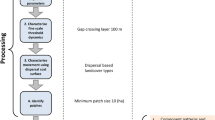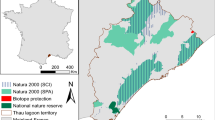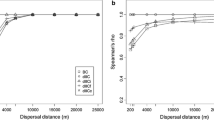Abstract
Context
Land use changes have modified the extent and structure of native vegetation, resulting in fragmentation of native species habitat. Connectivity is increasingly seen as a requirement for effective conservation in these landscapes, but the question remains: ‘connectivity for which species?’.
Objective
The aim of this study was to develop and then apply a rapid, expert-based, dispersal guild approach where species are grouped on similar fine-scale dispersal behaviour (such as between scattered trees) and habitat characteristics.
Methods
Dispersal guilds were identified using clustering techniques to compare dispersal and habitat parameters elicited from experts. We modelled least-cost paths and corridors between patches and individual movement probabilities within these corridors for each of the dispersal guilds using Circuitscape. We demonstrate our approach with a case study in the Tasmanian Northern Midlands, Australia.
Results
The dispersal guild approach grouped the 12 species into five dispersal guilds. The connectivity modelling of those five guilds found that broadly dispersing species in this landscape, such as medium-sized carnivorous mammals, were unaffected by fragmentation while from the perspective of the three dispersal guilds made up of smaller mammals, the landscape appeared highly fragmented.
Conclusions
Our approach yields biologically defensible outputs that are broadly applicable, particularly for conservation planning where data and resources are limited. It is a useful first step in multi-species conservation planning which aims to identify those species most in need of conservation efforts.





Similar content being viewed by others
References
Adriaensen F, Chardon JP, De Blust G, Swinnen E, Villalba S, Gulinck H, Matthysen E (2003) The application of “least-cost” modelling as a functional landscape model. Landsc Urban Plan 64:233–247
Alagador D, Triviño M, Cerdeira JO, Brás R, Cabeza M, Araújo MB (2012) Linking like with like: optimising connectivity between environmentally-similar habitats. Landsc Ecol 27:291–301
Beier P, Brost B (2010) Use of land facets to plan for climate change: conserving the arenas, not the actors. Conserv Biol 24:701–710
Beier P, Majka DR, Newell SL (2009) Uncertainty analysis of least-wildlife for designing linkages. Ecol Appl 19:2067–2077
Blaum N, Mosner E, Schwager M, Jeltsch F (2011) How functional is functional? Ecological groupings in terrestrial animal ecology: towards an animal functional type approach. Biodivers Conserv 20:2333–2345
Bottrill MC, Joseph LN, Carwardine J, Bode M, Cook C, Game ET, Grantham H, Kark S, Linke S, McDonald-Madden E, Pressey RL, Walker S, Wilson KA, Possingham HP (2008) Is conservation triage just smart decision making? Trends Ecol Evol 23:649–654
Brás R, Cerdeira JO, Alagador D, Araújo MB (2013) Linking habitats for multiple species. Environ Model Softw 40:336–339
Brodie JF, Giordano AJ, Dickson B, Hebblewhite M, Bernard H, Mohd-Azlan J, Anderson J, Ambu L (2014) Evaluating multispecies landscape connectivity in a threatened tropical mammal community. Conserv Biol 29:122–132
Brook BW, Sodhi NS, Bradshaw CJA (2008) Synergies among extinction drivers under global change. Trends Ecol Evol 23:453–460
Brost BM, Beier P (2012) Comparing linkage designs based on land facets to linkage designs based on focal species. PLoS ONE 7:e48965
Brown M (2011) Land use Tasmania: a technical report outlining the creation of the Draft Tasmanian summer 2009/2010. Unpublished report DPIPWE, Tasmania
Caughley G (1994) Directions in conservation biology. J Anim Ecol 63:215–244
Clevenger AP, Wierzchowski J, Chruszcz B, Gunson K (2002) GIS-generated, expert-based models for identifying wildlife habitat linkages and planning mitigation passages. Conserv Biol 16:503–514
CMP (2013) Open standards for the practice of conservation, version 3. Conservation Measures Partnership
Compton BW, McGarigal K, Cushman SA, Gamble LR (2007) A resistant-kernel model of connectivity for amphibians that breed in vernal pools. Conserv Biol 21:788–799
Cushman SA, Landguth EL (2012) Multi-taxa population connectivity in the Northern Rocky Mountains. Ecol Model 231:101–112
Cushman SA, Mcrae B, Adriaensen F, Beier P, Shirley M, Zeller K (2013) Biological corridors and connectivity. Key Top Conserv Biol 2:384–404
Dale MRT, Fortin M-J (2010) From graphs to spatial graphs. Annu Rev Ecol Evol Syst 41:21–38
Department of Environment (2014) Australia’s 15 national biodiversity hotspots. Commonw Gov. http://www.environment.gov.au/biodiversity/conservation/hotspots/national-biodiversity-hotspots#hotspot4
Doerr VAJ, Doerr ED, Davies MJ (2011) Dispersal behaviour of Brown Treecreepers predicts functional connectivity for several other woodland birds. Emu 111:71–83
Doerr ED, Doerr VAJ, Davies MJ, Mcginness HM (2014) Does structural connectivity facilitate movement of native species in Australia’s fragmented landscapes?: a systematic review protocol. Environ Evid 3:1–8
DPIPWE (2013) TASVEG 3.0. Tasmanian vegetation monitoring and mapping program. Resource Management and Conservation Division, Hobart, Tasmania
Drielsma M, Manion G, Ferrier S (2007) The spatial links tool: automated mapping of habitat linkages in variegated landscapes. Ecol Model 200:403–411
Etherington TR, Holland PE (2013) Least-cost path length versus accumulated-cost as connectivity measures. Landscape Ecol 28:1223–1229
Fischer J, Lindenmayer DB (2002) The conservation value of paddock trees for birds in a variegated landscape in southern New South Wales. 1. Species composition and site occupancy patterns. Biodivers Conserv 11:807–832
Fischer J, Lindenmayer DB (2006) Habitat fragmentation and landscape change: an ecological and conservation synthesis. Island Press, Washington
Foltête JC, Clauzel C, Vuidel G (2012) A software tool dedicated to the modelling of landscape networks. Environ Model Softw 38:316–327
Foltête J-C, Girardet X, Clauzel C (2014) A methodological framework for the use of landscape graphs in land-use planning. Landsc Urban Plan 124:140–150. doi:10.1016/j.landurbplan.2013.12.012
Frey-Ehrenbold A, Bontadina F, Arlettaz R, Obrist MK (2013) Landscape connectivity, habitat structure and activity of bat guilds in farmland-dominated matrices. J Appl Ecol 50:252–261
Gadsby S, Lockwood M, Moore S, Curtis A (2013) Tasmanian midlands socio-economic profile. Hobart, Tasmania, Landscape and Policy Hub, University of Tasmania
Haddad NM, Bowne DR, Cunningham A, Danielson BJ, Levey DJ, Sargent S, Spira T (2003) Corridor use by diverse Taxa. Ecology 84:609–615
Hawkins CE, Baars C, Hesterman H, Hocking GJ, Jones ME, Lazenby B, Mann D, Mooney N, Pemberton D, Pyecroft S, Restani M, Wiersma J (2006) Emerging disease and population decline of an island endemic, the Tasmanian devil Sarcophilus harrisii. Biol Conserv 131:307–324
Hollings T, Jones M, Mooney N, McCallum H (2013) Wildlife disease ecology in changing landscapes: mesopredator release and toxoplasmosis. Int J Parasitol Parasites Wildl 2:110–118
Kaufman L, Rousseeuw PJ (1990) Finding groups in data: an introduction to cluster analysis. Wiley, New York
Koen EL, Bowman J, Sadowski C, Walpole AA (2014) Landscape connectivity for wildlife: development and validation of multispecies linkage maps. Methods Ecol Evol 5:626–633
LaRue MA, Nielsen CK (2008) Modelling potential dispersal corridors for cougars in midwestern North America using least-cost path methods. Ecol Model 212:372–381
Lechner AM, Brown G, Raymond CM (2015a) Modeling the impact of future development and public conservation orientation on landscape connectivity for conservation planning. Landscape Ecol 30:699–713
Lechner AM, Doerr V, Harris RMB, Doerr E, Lefroy EC (2015b) A framework for incorporating fine-scale dispersal behaviour into biodiversity conservation planning. Landsc Urban Plan 141:11–23
Lechner AM, Harris RMB, Doerr V, Doerr E, Drielsma M, Lefroy EC (2015c) From static connectivity modelling to scenario-based planning at local and regional scales. J Nat Conserv 28:78–88
Lechner AM, Lefroy EC (2014) General approach to planning connectivity from LOcal Scales to Regional (GAP CLoSR): combining multi-criteria analysis and connectivity science to enhance conservation outcomes at regional scale. Centre for Environment, University of Tasmania. www.nerplandscapes.edu.au/publication/GAP_CLoSR
McRae BH, Dickson BG, Keitt TH, Shah VB (2008) Using circuit theory to model connectivity in ecology, evolution, and conservation. Ecology 89:2712–2724
McRae BH, Hall SA, Beier P, Theobald DM (2012) Where to restore ecological connectivity? Detecting barriers and quantifying restoration benefits. PLoS ONE 7:e52604
McRae BH, Kavanagh DM (2011) Linkage mapper connectivity analysis software. The Nature Conservancy, Seattle
Minor ES, Urban DL (2007) Graph theory as a proxy for spatially explicit population models in conservation planning. Ecol Appl 17:1771–1782
Minor ES, Urban DL (2008) A graph-theory framework for evaluating landscape connectivity and conservation planning. Conserv Biol 22:297–307
Mooney C, Defenderfer D, Anderson M (2010) Reasons why farmers diversify northern midlands, Tasmania. Rural Industries Research and Development Corporation, Canberra
Noon BR, McKelvey KS, Dickson BG (2009) Multispecies conservation planning on U.S. Federal Lands. Models for Planning Wildlife Conservation in Large Landscapes. doi:10.1016/B978-0-12-373631-4.00003-4
Park C, Allaby M (2013) A Dictionary of Environment and Conservation, 2nd edn. Oxford University Press, Oxford
Pascual-Hortal L, Saura S (2006) Comparison and development of new graph-based landscape connectivity indices: towards the priorization of habitat patches and corridors for conservation. Landscape Ecol 21:959–967
Poiani KA, Richter BD, Anderson MG, Richter HE (2000) Biodiversity conservation at multiple scales: functional sites, landscapes, and networks. BioScience 50:133
Rayfield B, Fortin MJ, Fall A (2011) Connectivity for conservation: a framework to classify network measures. Ecology 92:847–858
Rudnick DA, Ryan SJ, Beier P, Cushman SA, Dieffenbach F, Epps C, Gerber LR, Hartter J, Jenness JS, Kintsch J, Merenlender AM (2012) The role of landscape connectivity in planning and implementing conservation and restoration priorities. Issue Ecol 16:1–23
Saura S, Pascual-Hortal L (2007) A new habitat availability index to integrate connectivity in landscape conservation planning: comparison with existing indices and application to a case study. Landsc Urban Plan 83:91–103
Saura S, Torné J (2009) Conefor Sensinode 2.2: a software package for quantifying the importance of habitat patches for landscape connectivity. Environ Model Softw 24:135–139
Sawyer SC, Epps CW, Brashares JS (2011) Placing linkages among fragmented habitats: do least-cost models reflect how animals use landscapes? J Appl Ecol 48:668–678
Smith MJ, Forbes GJ, Betts MG (2013) Landscape configuration influences gap-crossing decisions of northern flying squirrel (Glaucomys sabrinus). Biol Conserv 168:176–183
Sprod D (2013) A structural vegetation cover dataset for the Midlands of Tasmania. Unpublished report, Tasmanian Land Conservancy, Hobart
Suzuki R, Shimodaira H (2006) Pvclust: an R package for assessing the uncertainty in hierarchical clustering. Bioinformatics 22:1540–1542
Synes NW, Watts K, Palmer SCF, Bocedi G, Bartoń KA, Osborne PE, Travis JMJ (2015) A multi-species modelling approach to examine the impact of alternative climate change adaptation strategies on range shifting ability in a fragmented landscape. Ecol Inform 30:222–229
The Nature Conservancy (2007) Conservation action planning: developing strategies taking action, and measuring success at any scale. Overview of Basic Practices Version, February 2007
Tournant P, Afonso E, Roué S, Giraudoux P, Foltête JC (2013) Evaluating the effect of habitat connectivity on the distribution of lesser horseshoe bat maternity roosts using landscape graphs. Biol Conserv 164:39–49
Urban D, Keitt T (2001) Landscape connectivity: a graph-theoretic perspective. Ecology 82:1205–1218
Van Der Ree R, Bennett AF, Gilmore DC (2004) Gap-crossing by gliding marsupials: thresholds for use of isolated woodland patches in an agricultural landscape. Biol Conserv 115:241–249
Zeller KA, McGarigal K, Whiteley AR (2012) Estimating landscape resistance to movement: a review. Landscape Ecol 27:777–797
Acknowledgments
This project was funded by the Australian Government Sustainable Regional Development Program in conjunction with the National Environmental Research Program’s Landscapes and Policy research Hub. We would like to thank the following people who contributed to this research Amy Koch, Bronwyn Fancourt, Chris Johnson, Christine Fury, Erik Doerr, Felicity Faulkner, Gareth Davies, Kirsty Dixon, Kirstin Proft, Louise Gilfedder, Mat Appleby, Menna Jones, Neil Davidson, Nick Fitzgerald, Rebecca Harris, Sarah Maclagan, Shannon Troy and Veronica Doerr. We would also like to thank the two peer reviewers (Robby Marrotte and an anonymous reviewer) for their insightful and constructive comments which greatly improved the clarity of the paper.
Author information
Authors and Affiliations
Corresponding author
Electronic supplementary material
Below is the link to the electronic supplementary material.
Rights and permissions
About this article
Cite this article
Lechner, A.M., Sprod, D., Carter, O. et al. Characterising landscape connectivity for conservation planning using a dispersal guild approach. Landscape Ecol 32, 99–113 (2017). https://doi.org/10.1007/s10980-016-0431-5
Received:
Accepted:
Published:
Issue Date:
DOI: https://doi.org/10.1007/s10980-016-0431-5




